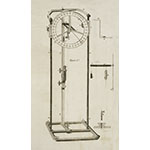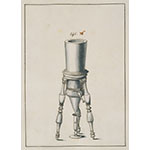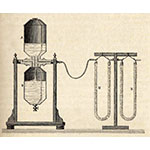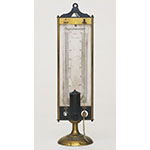Instrument for determining atmospheric humidity by measuring the quantity of aqueous vapor in the air. For this purpose, several types of hygrometer have been devised since the fifteenth century.
This model exploits the property of some organic substances, known as "hygroscopic," to absorb humidity from the air. Hair, oat-beard, many animal and plant fibers, and paper are hygroscopic: they undergo slight changes in shape in response to the variations in air humidity. Hygrometers based on this phenomenon are not very precise and give qualitative rather than quantitative results.
Instrument that measures the temperature at which the aqueous vapor in the atmosphere condenses. When the temperature of a vessel is artificially lowered, the vessel is eventually covered with condensed vapor: this is known as the "dew point." By comparing the temperature of the dew point (which depends on atmospheric humidity) with the external temperature, we can determine the percentage of vapor in the air. This is a fairly accurate way to establish atmospheric humidity, which is a function both of the external temperature and of the condensation temperature.
In this type of hygrometer, atmospheric humidity is calculated by measuring the changes in the weight of substances that absorb the aqueous vapor.
The term psychrometer, coined in 1818 by the German inventor Ernst Ferdinand August (1795-1870), derives from the Greek and means "cold measurer." It is a hygrometric instrument based on the principle that dry air promotes evaporation, while wet air hinders it. The psychrometer is equipped with two identical thermometers: one with a dry bulb, the other with a bulb kept continuously moist by a wet band. The lower the atmospheric humidity, the higher the rate of water evaporation on the wet bulb, which causes a lowering of the temperature. From the temperature difference between the two thermometers, the degree of atmospheric humidity can be measured using appropriate tables. The temperature difference is zero when relative humidity is 100%.











